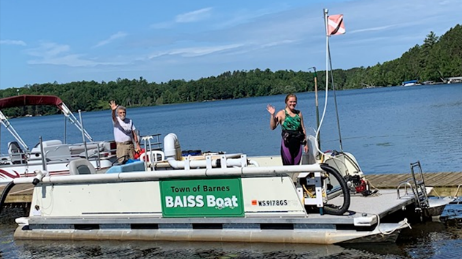The following was written by Ted Eastlund, who volunteers on the Barnes Area Invasive Species Suction (BAISS) Pontoon Boat. On Tuesday, June 23, 2020, the BAISS boat crew spent six hours on Upper Eau Claire Lake collecting curly-leaf pondweed.
Barnes Area Invasive Species Suction (BAISS) Pontoon Boat Crew on June 23
- Volunteer Ted Eastlund. Captain, Navigator, Aft Crew, Water Intake Manager, Aquatic Plant Processor and Bagger, Deckhand,
- Alexis “Alex” Kabasa. Diver, Fore Crew, Aquatic Plant Collection Crew, Boat Navigator, Diver Safety Monitor, Diver Air Supply and Plant Intake manager. She is a recent University graduate majoring in Law Enforcement hoping for a job in the jail system.
- Cris Neff. Replacement Backup Diver, Fore Crew, Aquatic Plant Collection Crew, Boat Navigator, Diver Safety Monitor, Diver Air Supply and Plant Intake manager
- Gus Gustafson: Volunteer Crew Recruiter and Scheduler, Boat Daily Checker, Boat Engineer, Designer and Builder and Maintenance Manager, Embarkation and Disembarkation Manager, Boat Unloader, Record Keeper. Along with Rick Mattila, Gus designed and built the boat. He also keeps the boat supplied, gassed, repaired and running in addition to recruiting and scheduling the volunteer crew.
- Other Important People:
- Terry Bauer: normally the daily diver. From Bayfield, Terry taught biology and chemistry for 10-20 years mid-state and was a principal in Bayfield 5-10 years until he retired and opened a SCUBA shop in Bayfield.
- Quentin Ruprecht: property and dock owner. Disposes bags of AIS after each day of work on Middle Eau Claire Lake.
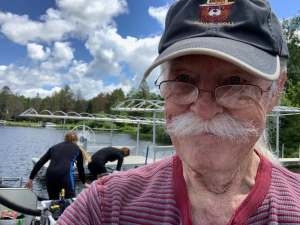

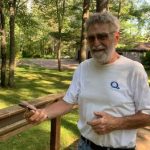
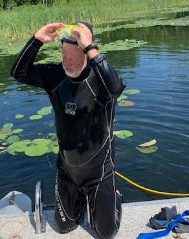

We collected curly-leaf pondweed Tuesday June 23 10am-4pm shift. Beautiful weather. Went well except for half an hour when aft motor kept stopping after 30 seconds. Corrected when gas line valve was opened “ON” correctly. Crew lives life with COVID precautions taken. On board on the lake we mostly maintained social distance without face masks.
One minor incident occurred twice requiring urgent action each time: This year the lake bottom at the collection site has a lot of black decayed finely dispersed vegetable matter. Twice the screen table was flooded with black water that suddenly occluded the screen openings and water quickly overflowed. I urgently pressed the upside-down white plastic “colander” bowl (the diffuser bowl) hard against the screen and scraped the screen back and forth and water flowed through and the screen table gradually emptied, leaving a coat of black muck. We didn’t turn off the water intake pump motor. It kept flowing hard and fast, lending urgency to the need to apply mitigating steps. During the second occurrence both screen tables completely overflowed the black muddy water onto the pontoon deck and me.
The plants we collected included:
- Curly-leaf pondweed (CLP, P. crispus). Stiff, finely-serrated edges. This was the most abundant specie. Plenty of turions. Healthy plants.
- Northern water milfoil. Second most abundant, had 12-14 leaflet pairs per feathery leaf (not 12-18), not limp, stem not hollow.
- Elodea. Had three leaves per whorl, therefore not invasive Hydrilla (4-8 leaves per whorl)
- Wild celery (few)
- Chara (rare)
- Bladderwort (rare)
Animals we found were:
- One crayfish
- Chinese Mystery Snail (one large, a few small)
- Few tiny clams
- One leech
Staffing and duration of collection are different from previous years. Now 6 hours, it was 4 hours per day last year.
Last year, the crew included one paid diver and two volunteer deck hands:
- One fore volunteer to monitor diver safety and communications, air supply and intake.
- One aft volunteer to process and bag collected plants, monitor the aft water intake motor, drive pontoon.
In 2020 there are two divers and generally one volunteer. Each diver takes turns underwater one hour. One diver always serves on deckas as fore crew to monitor air supply and diver safety and communications and net and collect floating plants.
The single aft volunteer now serves as pontoon boat captain, plant processor and bagger, and water intake motor monitor. Duties are:
- Bag collected plants. Due to weight of collection, we now call a “full bag” when it fills to bottom PVC rung (around 1.5 to 2 feet above deck).
- Monitor water intake pump motor. Keep it running. Shut it off on request by divers.
- Fuel line valve. Keep open.
- Choke, to the left to choke and start motor, then move to right to keep carburetor open during operations.
- On/Off valve (on back side of motor next to pontoon railing wall).
- Keep gas tank with fuel. May need one filling onboard per day.
- Make sure only pure gas is used.
- The other gas tank with gas and oil is for the boat motor.
- Otherwise both tanks are identical.
- Drive pontoon boat to collection sites and back to landing.
- You will be trained how to use the handheld GPC Garmin.
- The screen displays an arrow and aids locating target CLP patch. When you see the boat (arrow) on top of the marker (anchor symbol), stop and divers will find the CLP.
- You will learn how to mark CLP/collection sites.
- In the Volunteer Log, enter your name, sites visited, hours worked and how many miles you drove round-trip form home to lake site.
- On return, place bags on shore.
- Clean some after operation.

On June 23, we collected what looks like a Chinese Mystery Snail (they have been reported in Upper ECL). One large one found at the dock where we were removing CLP across from the island at site GP2. When opened to remove and save its beautiful operculum, many large eggs were found.
The peninsula shoreline lake bottom where the boat is docked overnight contains many Chinese Mystery Snails and fresh water clams.


Operculum from a Chinese Mystery Snail, an invasive specie.
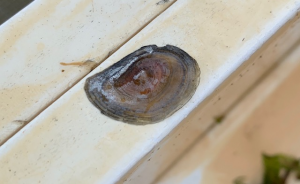
LEFT: Chinese Mystery Snail operculum external surface with calcifications.
RIGHT: Internal surface of snail operculum.
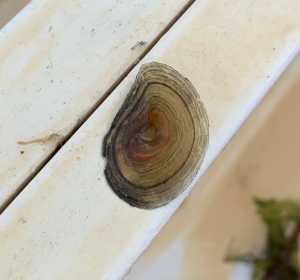

Probably Chara, a native algae. Very few found near dock at beginning of collection.
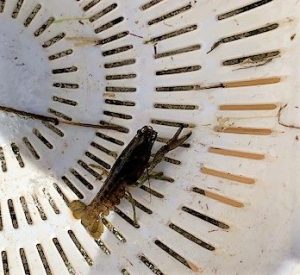
A small crayfish was collected along with the plants. Perhaps not a rusty crayfish but I didn’t examine in detail. Tail had that central dark line that is missing on Rusty Crayfish. One claw larger than a tiny one (not big). Couldn’t see any bilateral dark spots on carapace. Approximately 3 inches long.
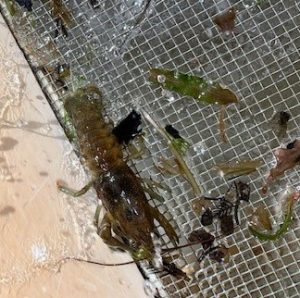

Some years back Rusty Crayfish were so abundant in the Eau Claire Lakes that some people were trying to collect them and sell to restaurants. Then they disappeared.
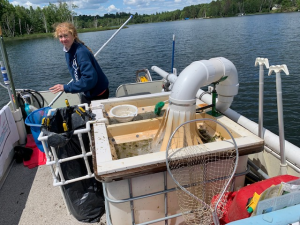
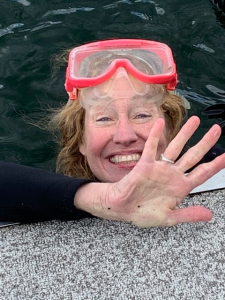
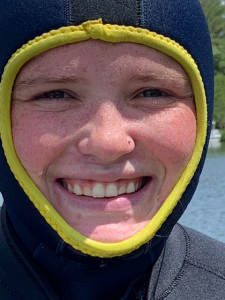

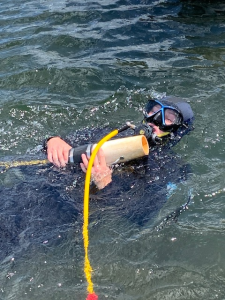

A beautiful curly-leaf pondweed turion. They ranged from greenish with leaves to all brown, sharp and woody.
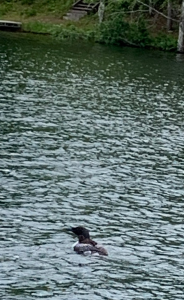
After the work shift was over we headed home. We saw a pair of loons with a baby chick that hatched in the past day or two. They incubated the egg on the artificial platform near the island very close to our collection site. Here is a loon parent with the newly hatched chick riding on the back of the parent.
